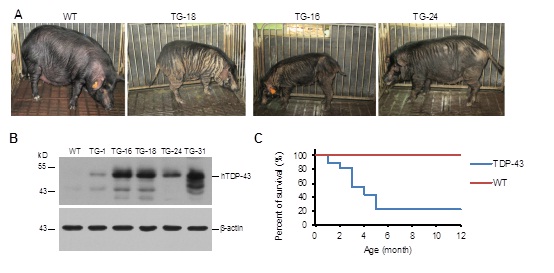Amyotrophic lateral sclerosis (ALS) is characterized by progressive degeneration of large motor neurons in the spinal cord and cerebral cortex, which results difficulty in speaking, swallowing, and eventually breathing. ALS can be caused by genetic mutations in the genes encoding TAR DNA-binding protein 43 (TDP-43), the Cu-Zn superoxide dismutase (SOD1), and the RNA/DNA-binding protein fused in sarcoma (FUS). Mutant TDP-43 is a nuclear protein but can accumulate in the cytoplasmic region of the neuronal cells in ALS patient brain. However, this typical pathological change is hardly seen in transgenic mouse models that express mutant TDP-43.
Two scientists at Chinese Academy of Sciences, Dr. LI Xiao-Jiang at Institute of Genetics and Developmental Biology and Dr. LAI Liangxue at Guangzhou Institute of Biomedicine and Health, have been collaborating to establish transgenic pig models of neurodegenerative diseases. Their previous work generated transgenic pig models for Huntington disease (Yang et al., Hum Mol Genet, 2014) and SOD-1-mediated ALS (Yang et al., Cell Res. 2014).
They recently established transgenic pigs that express mutant TDP-43 to model ALS. This new transgenic ALS pig model shows the cytoplasmic accumulation of mutant TDP-43 in a way similar to that in ALS patient brains. Further, their studies show that the aberrant cytoplasmic accumulation of mutant TDP-43 can lead to the mislocalization of RNA splicing factors and reduced expression of genes for neuronal function.
Since transgenic ALS mouse models do not mimic the cytoplasmic accumulation of mutant TDP-43, the findings from Drs LI and LAI’s groups indicates that the species differences can determine the nature of neuropathology and underscores the importance in utilizing large animal models to investigate the pathogenesis of neurodegenerative diseases.
This work was published on September 3, 2015 by the journal Molecular Neurodegeneration (http://www.ncbi.nlm.nih.gov/pubmed/26334913). The work was supported by grants from the National Basic Research Program of China (973 program), the Natural Science Foundation of China, and NIH.

Figure. (A) Photographs of representative non-transgenic (WT) and TDP-43 transgenic pig (TG-16, 18, 24) at 9 months of age. (B) Western blots analysis of ear tissues showing the expression of transgenic TDP-43 pigs that were monitored for their body weights. (C) Survival plot showing that expression of mutant TDP-43 caused early death of TDP-43 transgenic (TG) pigs (n = 12 for non-TG (WT) and n = 27 for TG). (Image by IGDB)
Contact:
LI Xiao-Jiang, Principal Investigator
Institute of Genetics and Developmental Biology, Chinese Academy of Sciences, Beijing, China
Phone: 86-010-64807885
Email: xjli@genetics.ac.cn



